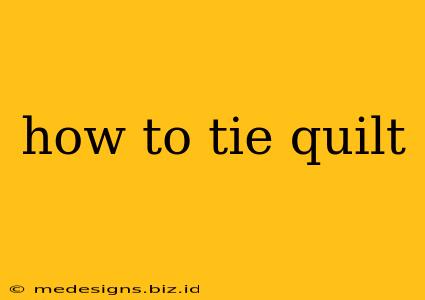So, you've painstakingly pieced together your quilt top, lovingly layered it with batting and backing, and now you're staring at a mountain of fabric, wondering, "How do I actually finish this thing?" Don't worry, you're not alone! Many quilters, especially beginners, find the finishing process daunting. But tying a quilt is a surprisingly simple and satisfying method, perfect for achieving a charming, rustic look. This guide will walk you through every step.
Why Choose Tying?
Tying a quilt is a great alternative to quilting (stitching) it, offering several advantages:
- Simplicity: It's much faster and easier than quilting, making it ideal for beginners or those short on time.
- Rustic Charm: The tied knots create a unique texture and a lovely, homespun aesthetic.
- Flexibility: You can adapt the spacing of your knots to suit your design and the overall look you want to achieve.
- Less Equipment: You don't need a sewing machine or specialized quilting tools.
Supplies You'll Need:
- Your quilt layers: Pre-assembled quilt top, batting, and backing.
- Quilt basting spray (optional): Makes the layers easier to manage.
- Scissors: To trim any excess fabric.
- Yarn or embroidery floss: Choose a color that complements your quilt.
- Large needle: A blunt-ended tapestry needle works well.
- Measuring tape or ruler: For consistent knot spacing.
Step-by-Step Guide to Tying Your Quilt:
1. Baste Your Quilt Layers
First, you need to secure your quilt top, batting, and backing together. This prevents the layers from shifting while you tie. You can use:
- Basting spray: The easiest and quickest method. Follow the manufacturer's instructions carefully.
- Safety pins: A more time-consuming but effective method. Pin every 4-6 inches around the perimeter and then at intervals across the quilt top.
- Hand basting: The most traditional but also the most time-consuming method. Use a long basting stitch to secure the layers.
Pro Tip: Regardless of your chosen method, ensure your layers are smooth and free of wrinkles before proceeding.
2. Plan Your Knot Placement
Decide how far apart you want your knots. A common spacing is 4-6 inches, but you can adjust it based on your preference and the size of your quilt. Even spacing is key for a polished look, but slight variations add to the handmade charm.
3. Tie the Knots
This is where the fun begins! Follow these steps for each knot:
- Insert the needle: Bring the needle up from the back of the quilt, leaving a short tail.
- Make a knot: Bring the needle back down through the layers, approximately 1-2 inches away from your initial insertion point.
- Secure the knot: Gently pull the yarn until the knot is snug against the quilt layers, but not so tight that it puckers the fabric. Try to keep the knot somewhat flat against the layers.
4. Finishing Touches
Once you've tied all the knots, trim the excess yarn close to the knot. You can leave a slightly longer tail for a more rustic look, but make sure it's not so long that it becomes a tripping hazard.
5. Admire Your Work!
And there you have it! Your quilt is tied and ready to be loved. Remember, tying a quilt is a forgiving process. Don’t be afraid to experiment and find a knot placement and tension that you're happy with. The imperfections are part of the charm!
Tips for Success:
- Use a good quality yarn or embroidery floss: It should be strong enough to hold up over time and not break easily.
- Don't pull the knots too tight: This can pucker the fabric and ruin the look of your quilt.
- Work in sections: Tying a large quilt can be tedious. Break it down into smaller sections to make the task feel less overwhelming.
- Practice on scraps: Before starting on your actual quilt, practice tying knots on some fabric scraps to get a feel for the process.
Tying a quilt is a wonderful way to create a beautiful and unique handmade item. Enjoy the process and the satisfaction of completing your project!
